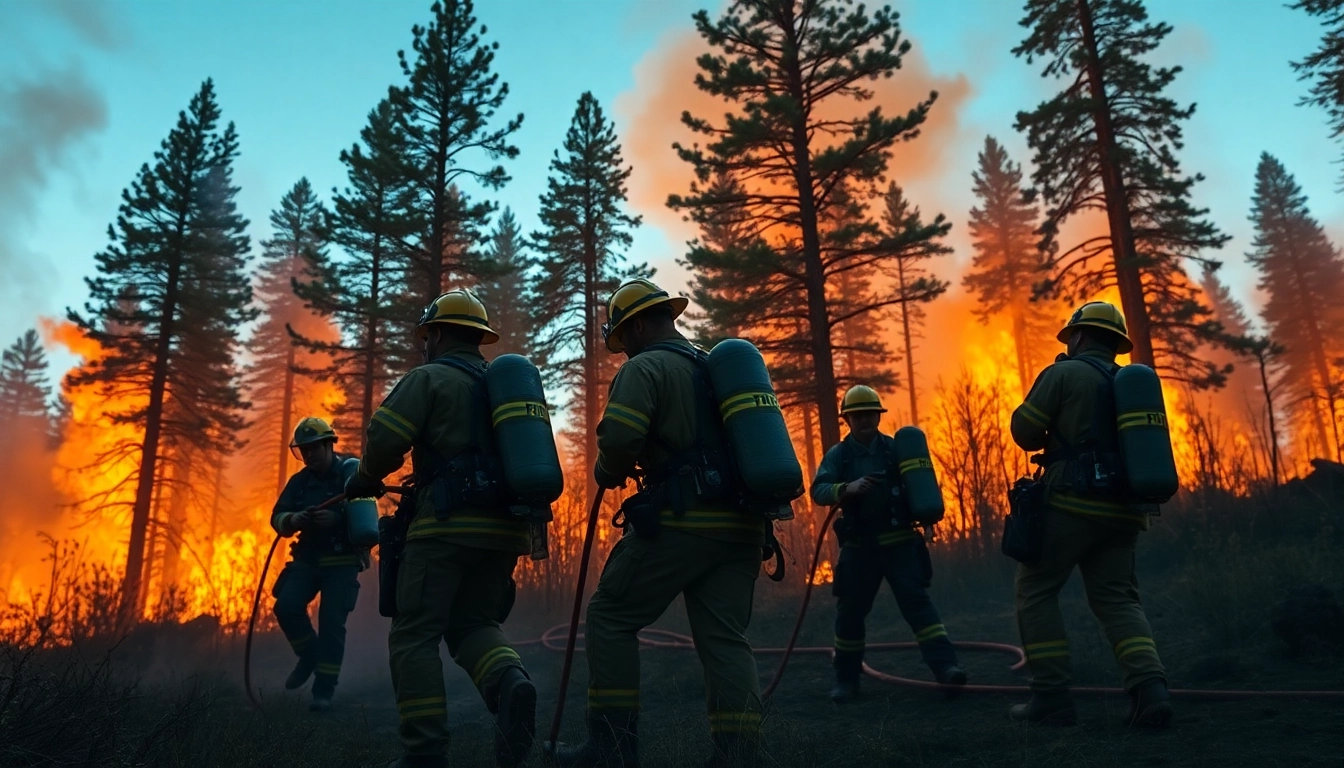What Are Wildfire Events?
Definition and Importance of Wildfire Events
Wildfire events refer to uncontrolled fires that spread through vegetation, predominantly in forested areas. These events can have extensive ecological, economic, and social repercussions. They are crucial in shaping landscapes, influencing biodiversity, and restoring ecological balance. Understanding wildfire events is essential not only for effective management but also for conservation efforts and community safety. As the frequency and intensity of these events rise, especially due to climate change and urban expansion, it becomes ever more critical to engage with practices that prevent and mitigate their impacts. The significance of wildfire events cannot be overstated, as they affect wildlife habitats, air quality, and even global climate systems.
The Role of Weather in Wildfire Events
Weather conditions significantly affect the likelihood and severity of wildfire events. Hot, dry, and windy climates are traditionally viewed as prime conditions for wildfires. Factors such as humidity, temperature, precipitation, and wind speed play an essential role in fire dynamics. Understanding these weather parameters is critical in predicting wildfire behavior, facilitating timely evacuations, and informing suppression strategies.
For example, during prolonged drought periods, vegetation becomes exceptionally dry and more susceptible to ignition. Furthermore, strong winds can rapidly propagate flames, facilitating the spread of fire across large areas. Consequently, fire management agencies constantly monitor weather patterns and develop predictive models to anticipate fire risks and prepare adaptive measures.
Common Causes and Conditions for Wildfire Events
Wildfire events can be ignited by natural causes or human activity. Each year, millions of acres are burned due to factors such as lightning strikes, ember storms, and volcanic eruptions. Nevertheless, human activity remains the primary cause of most wildfires. These activities can include:
- Unattended campfires
- Discarded cigarettes
- Equipment use and malfunctions
- Intentional arson
- Fireworks
In addition to ignition sources, specific conditions can exacerbate fire risks. Regions with dense underbrush, dead vegetation, or invasive plant species often experience higher wildfire hazards. Moreover, as urban areas expand into wildland regions, the interface between human habitation and wildfire-prone terrain increases, leading to greater challenges in fire management.
Impacts of Wildfire Events on Communities
Environmental Effects of Wildfire Events
The environmental impacts of wildfire events can be profound and long-lasting. The immediate aftermath typically includes destruction of vegetation, soil erosion, and habitat loss. Disturbed ecosystems may take years, if not decades, to recover fully. The loss of vegetation can also result in increased runoff and sedimentation in waterways, degrading water quality and affecting aquatic ecosystems.
In addition, wildfires release significant amounts of carbon dioxide and other greenhouse gases into the atmosphere, contributing to climate change. As such, they have implications beyond local ecosystems, affecting air quality and driving regional climate patterns. Certain management practices, like prescribed burning, aim to mimic natural fire cycles to promote healthy ecosystems while mitigating the extreme effects of uncontrolled wildfires.
Economic Consequences of Wildfire Events
The economic repercussions of wildfire events are substantial. Wildfires can result in billions of dollars in damages each year, affecting industries such as tourism, agriculture, and real estate. Communities in fire-prone regions often face increased insurance premiums, reduced property values, and economic downturns due to loss of infrastructure and accessibility.
Moreover, the costs associated with firefighting efforts, evacuations, and rehabilitation can burden state and federal budgets. A comprehensive economic assessment of wildfire impacts considers not just immediate damage, but also the long-term effects on community resilience, public health, and social cohesion. Thus, investing in effective wildfire prevention strategies yields favorable returns in economic and social well-being.
Health Risks Associated with Wildfire Events
Wildfire events pose considerable health risks to affected populations. Smoke inhalation can lead to respiratory problems, cardiovascular issues, and exacerbation of pre-existing health conditions. Vulnerable groups, including children, the elderly, and individuals with chronic illnesses, face particularly heightened risks.
In addition to respiratory and health impacts, wildfire events can result in psychological stress among communities facing evacuations and property losses. Community resilience programs and mental health resources must be integrated into wildfire management efforts to support affected populations adequately. Monitoring of air quality and public health advisories are critical during wildfire seasons to safeguard community health.
Preventing Wildfire Events: Best Practices
Community Preparedness for Wildfire Events
Community preparedness is key to effective wildfire event management. Ensuring that residents are informed and equipped to handle potential threats can significantly reduce risks and enhance resilience. Community preparedness activities can include:
- Wildfire education programs to inform residents about fire risks and safety measures.
- Creating defensible space around properties through the removal of combustible materials.
- Conducting regular drills and simulations for emergency response and evacuation procedures.
- Forming neighborhood fire watch programs to promote vigilance and quick communication during fire threats.
Furthermore, engaging local organizations and stakeholders in planning efforts can foster collaboration and resource sharing, ultimately benefiting community preparedness.
Effective Fire Management Strategies
Implementing effective fire management strategies is essential for reducing wildfire risks. These strategies may include:
- Controlled burns to decrease fuel load and promote healthy ecosystems.
- Regular maintenance of transportation and utility corridors to eliminate excess vegetation.
- Creating buffer zones in high-risk areas to protect communities from potential fires.
- Continuous risk assessment and enhancement of local firefighting capabilities.
Fire management should incorporate a multisector approach, combining efforts from local governments, fire departments, and ecological organizations. Using data-driven analyses and predictive modeling helps allocate resources efficiently and prioritize actions based on observed fire behaviors.
Role of Technology in Preventing Wildfire Events
Advancements in technology significantly enhance wildfire prevention efforts. Tools such as remote sensing, satellite imagery, and predictive modeling assist fire management agencies in assessing risks and responding more effectively to wildfire events. Technologies such as:
- Drones for aerial surveys and real-time monitoring of fire conditions.
- Weather stations providing localized data on temperature, humidity, and wind conditions.
- Mobile applications that disseminate alerts and safety information to residents in real time.
Additionally, community engagement platforms using social media and public forums can foster greater awareness and information sharing, promoting proactive wildfire behaviors among the public.
Responding to Wildfire Events: Emergency Action Plans
Evacuation Strategies During Wildfire Events
Effective evacuation strategies are critical in minimizing loss of life and property during wildfire events. Clear evacuation routes must be established and communicated to residents well in advance. Local authorities should regularly review and update these routes based on community feedback and changing risk assessments.
Evacuation plans should include provisions for individuals with special needs, such as elderly residents or those with disabilities, to ensure they receive the appropriate support during emergencies. Public education campaigns can enhance awareness of evacuation procedures, with visual aids and regular community meetings to reinforce these plans.
Communication and Coordination in Wildfire Events
Effective communication and coordination among various stakeholders are pivotal during wildfire events. This involves collaboration between local government agencies, fire departments, emergency services, and community organizations. Implementing a clear communication strategy can facilitate timely updates and enhance public safety.
Utilizing multiple communication channels, including social media, automated emergency alerts, and community bulletin boards, ensures that diverse segments of the population receive critical information. Regular coordination meetings before the wildfire season can facilitate smoother operations between organizations, ultimately improving community responses during actual events.
Post-Event Recovery and Support
Recovering from wildfire events can be daunting for affected communities. Immediate post-event support should focus on assessing damage, providing psychological support, and offering resources for rebuilding. Recovery programs need to address not only physical infrastructure but also emotional wellbeing, ensuring that residents have access to mental health services.
Long-term recovery strategies should involve community engagement to rebuild in more resilient ways, incorporating sustainable practices to minimize future wildfire risks. Community forums can serve as platforms where residents can voice their concerns and collaboratively develop recovery plans that reflect shared goals and values.
Future of Wildfire Events: Trends and Predictions
Influence of Climate Change on Wildfire Events
Climate change is expected to significantly alter the landscape of wildfire events worldwide. Increased temperatures, prolonged droughts, and erratic precipitation patterns will likely exacerbate existing fire risks, leading to more frequent and intense fire events. Understanding these changing conditions is vital for effective wildfire management and resiliency planning.
In the future, governments and organizations will need to adopt adaptive policies that respond to evolving climatic challenges. This requires a shift in resource allocation and prioritizing long-term sustainability among ecosystem management practices.
Adapting Policies for Increasing Wildfire Events
Policymaking will play a crucial role in addressing the risks associated with increasing wildfire events. Comprehensive wildfire management policies must integrate land use planning, ecological protection, and community resilience frameworks. Policymakers should ensure that regulations support proactive measures while providing communities with the tools to prepare adequately for wildfire threats.
Investments in infrastructure, workforce training, and resource allocation are essential to transitioning toward a more sustainable and adaptive management approach. As climatic conditions shift, regulations must remain flexible to incorporate new knowledge and innovations in wildfire science.
Community Engagement in Wildfire Events Management
Community engagement is crucial for successful wildfire event management. Local involvement in decision-making processes empowers residents and creates a sense of ownership over preventive measures. This engagement can take the form of participatory planning sessions, educational workshops, and volunteer firefighting programs.
Incorporating community feedback can help tailor wildfire strategies to local needs, ultimately resulting in more effective and relevant wildfire management practices. Moreover, fostering collaborations between residents and officials can create a culture of preparedness, ultimately enhancing community resilience against future wildfire events.











Leave a Reply